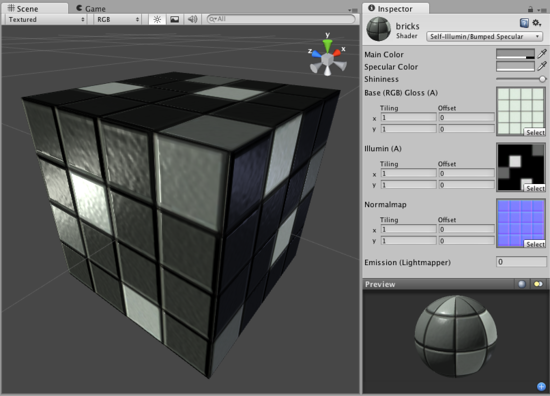Self-Illuminated Normal mapped Specular

Self-Illuminated Properties
This shader allows you to define bright and dark parts of the object. The alpha channel of a secondary texture will define areas of the object that “emit” light by themselves, even when no light is shining on it. In the alpha channel, black is zero light, and white is full light emitted by the object. Any scene lights will add illumination on top of the shader’s illumination. So even if your object does not emit any light by itself, it will still be lit by lights in your scene.
Normal Mapped Properties
Like a Diffuse shader, this computes a simple (Lambertian) lighting model. The lighting on the surface decreases as the angle between it and the light decreases. The lighting depends only on the angle, and does not change as the camera moves or rotates around.
Normal mapping simulates small surface details using a texture, instead of spending more polygons to actually carve out details. It does not actually change the shape of the object, but uses a special texture called a Normal Map to achieve this effect. In the normal map, each pixel’s color value represents the angle of the surface normal. Then by using this value instead of the one from geometry, lighting is computed. The normal map effectively overrides the mesh’s geometry when calculating lighting of the object.
Creating Normal maps
You can import a regular grayscale image and convert it to a Normal Map from within Unity. To learn how to do this, please read the Normal map FAQ page.
Technical Details
The Normal Map is a tangent space type of normal map. Tangent space is the space that “follows the surface” of the model geometry. In this space, Z always points away from the surface. Tangent space Normal Maps are a bit more expensive than the other “object space” type Normal Maps, but have some advantages:
- It’s possible to use them on deforming models - the bumps will remain on the deforming surface and will just work.
- It’s possible to reuse parts of the normal map on different areas of a model; or use them on different models.
Specular Properties
Specular computes the same simple (Lambertian) lighting as Diffuse, plus a viewer dependent specular highlight. This is called the Blinn-Phong lighting model. It has a specular highlight that is dependent on surface angle, light angle, and viewing angle. The highlight is actually just a realtime-suitable way to simulate blurred reflection of the light source. The level of blur for the highlight is controlled with the Shininess slider in the Inspector.
Additionally, the alpha channel of the main texture acts as a Specular Map (sometimes called “gloss map”), defining which areas of the object are more reflective than others. Black areas of the alpha will be zero specular reflection, while white areas will be full specular reflection. This is very useful when you want different areas of your object to reflect different levels of specularity. For example, something like rusty metal would use low specularity, while polished metal would use high specularity. Lipstick has higher specularity than skin, and skin has higher specularity than cotton clothes. A well-made Specular Map can make a huge difference in impressing the player.
Performance
Generally, this shader is moderately expensive to render. For more details, please view the Shader Peformance page.